Weekly Current Affairs (1st to 7th August 2025) - 2 | Weekly Current Affairs - UPSC PDF Download
GS3/Environment
Rain, Landslides, and Flash Floods: Rising Risks
Source: Indian Express
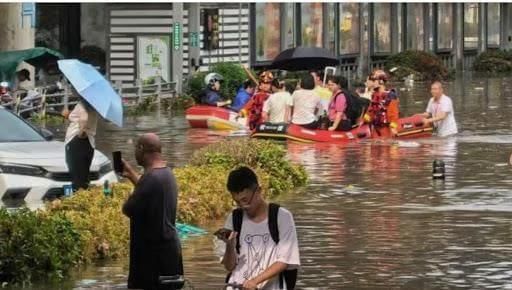 Why in News?
Why in News?
A flash flood in Dharali, Uttarkashi on August 5 resulted in the loss of at least four lives, with many others reported missing, alongside widespread destruction. Hundreds were displaced due to this incident, which is part of a series of extreme weather events, including one in Himachal Pradesh last month that claimed numerous lives and affected thousands.
Key Takeaways
- The precise cause of the Dharali flash flood remains unclear, though a glacial lake breach is a potential cause that has yet to be confirmed.
- The incident emphasizes the increasing disaster risks in ecologically sensitive areas and the challenges of implementing effective early warning and mitigation systems.
- Despite heavy rainfall in surrounding regions, Uttarkashi experienced below-normal precipitation prior to the flood.
Additional Details
- Rainfall Patterns: On August 5, the flood day, Uttarkashi recorded 32 mm of rain, which is double the daily normal but not classified as extreme rainfall. This contrasts with heavy rains in nearby districts on August 3 and 4.
- Cloudbursts: Defined by the IMD as at least 100 mm of rain within one hour over a 10x10 km area, cloudbursts are localized and may not be recorded if measurement instruments are absent in the affected zones.
- Flash floods in the Himalayas are typically caused by a combination of factors, including intense rainfall, landslides, steep slopes, and possible glacial breaks.
- In fragile terrains, even low-intensity rainfall can trigger landslides or floods due to saturated soil and eroding slopes.
- The young and geologically weak nature of the Himalayas makes them more susceptible to such disasters compared to older mountain ranges.
- Construction and heavy traffic further exacerbate the risk of flash floods during extreme rainfall events.
The situation in Dharali showcases the complexities of predicting flash floods, where even moderate rainfall can result in catastrophic events. While advances have been made in forecasting heavy rains and landslide predictions, the uncertainty in determining the likelihood of flash floods remains significant. Mitigation strategies such as restricting construction near riverbanks and relocating vulnerable settlements can help in reducing risks associated with these extreme weather events.
GS3/Economy
India’s Economic Equilibrium
Why in News?
India’s Finance Ministry has recently characterized the economy as being in a "Goldilocks situation," marked by moderate growth, low inflation, and favorable monetary conditions. Analysts have noted a strong GDP growth of 7.6%, peak interest rates, and stable corporate earnings. The country concluded FY2024 as a $3.6 trillion economy, suggesting optimism for 2025. However, experienced economists warn that this seemingly positive picture conceals deeper structural imbalances, rendering the perceived equilibrium more fragile than it appears.
Key Takeaways
- Inflation and stagnant wage growth challenge the "Goldilocks" narrative.
- Income inequality and fiscal pressures question the validity of the "Goldilocks" claim.
- Underlying economic fragilities extend beyond the "Goldilocks" illusion.
Additional Details
- Inflation Dynamics: Headline CPI inflation decreased from 4.8% in May 2024 to 2.82% by May 2025; however, food inflation remained problematic, with the Consumer Food Price Index (CFPI) reaching 10.87% in October 2024, significantly outpacing general inflation.
- Erosion of Real Wages: In 2023, an average nominal salary increase of 9.2% led to only a 2.5% real wage growth. In 2020, real wages even fell by 0.4%, despite nominal growth. Projections for 2025 indicate that real wage growth will be halved by inflation, further straining household budgets.
- Silent Squeeze on Households: Rising inflation diminishes the value of salary increases, leading to a decline in quality of life for many families, with increased financial uncertainty.
- Income Inequality: The decline in the Gini coefficient from 0.489 in AY13 to a projected 0.402 in AY23 reflects improvements limited to the formal sector, while the vast informal workforce remains excluded.
- Fiscal Pressures: The government aims to reduce the fiscal deficit from 6.4% in 2022-23 to 4.4% in 2025-26, but high deficits necessitate significant borrowing, potentially hindering private investment and economic growth.
In conclusion, while India’s economic indicators suggest a stable environment, the reality encompasses significant challenges, including volatile food inflation, stagnant real wages, persistent income inequality, and constrained fiscal space. Addressing these systemic issues is essential for achieving true economic equilibrium that benefits all segments of society.
GS3/Environment
Pollution Control can Levy Environmental Damages: Supreme Court Ruling
Why in News?
A landmark ruling by the Supreme Court of India has granted Pollution Control Boards (PCBs) the authority to impose and collect restitutionary and compensatory damages under the Water and Air Acts. This decision is pivotal in enhancing the enforcement of environmental protection standards across the country.
Key Takeaways
- The Supreme Court has empowered PCBs to impose and collect damages related to environmental harm.
- PCBs can demand bank guarantees in anticipation of potential environmental damage.
Additional Details
- Legal Basis:The ruling is grounded in:
- Section 33A of the Water Act, 1974: Grants authority to direct the closure or regulation of industries that violate water pollution norms.
- Section 31A of the Air Act, 1981: Provides similar powers to control air pollution, with non-compliance recognized as a legal violation.
- Central Pollution Control Board (CPCB): Established in September 1974 under the Water Act, the CPCB is a statutory technical body responsible for promoting clean air and water. It operates under the Environment (Protection) Act, 1986.
- Key Functions of CPCB:
- Control and abate water and air pollution; promote cleanliness of streams and wells.
- Advise the Central Government on pollution-related issues.
- Coordinate with State Pollution Control Boards (SPCBs) and resolve disputes.
- Monitor pollution in Union Territories through powers delegated under relevant Acts.
- Develop and revise National Ambient Air Quality Standards and Water Quality Criteria.
- State Pollution Control Boards (SPCBs): Formed by State Governments, these boards monitor and control local pollution, enforce compliance, and conduct awareness campaigns.
This ruling emphasizes the importance of proactive measures in environmental governance, enabling PCBs to take decisive actions against pollution and thereby enhancing the protection of natural resources in India.
GS2/International Relations
Intermediate-Range Nuclear Forces (INF) Treaty
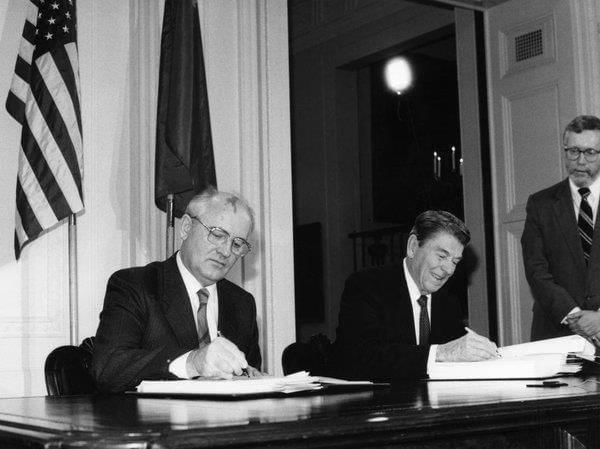 Why in News?
Why in News?
Russia has officially declared its withdrawal from the 1987 Intermediate-Range Nuclear Forces (INF) Treaty. This decision signifies a crucial shift in the landscape of Cold War-era nuclear arms control.
Key Takeaways
- The INF Treaty was signed in 1987 by U.S. President Ronald Reagan and Soviet leader Mikhail Gorbachev.
- The treaty prohibited ground-launched ballistic and cruise missiles with ranges from 500 to 5,500 kilometers.
- Its implementation resulted in the elimination of 2,692 missiles by June 1, 1991.
Additional Details
- Verification: The treaty allowed for on-site inspections, which set a precedent for future arms control agreements.
- Scope: It included both nuclear and conventional missile systems, becoming a cornerstone of post-Cold War strategic stability.
- Reasons for Russia's Exit: Russia cited U.S. military deployments, such as Tomahawk launchers in the Philippines and Dark Eagle hypersonic missiles in Australia, as key factors for its withdrawal. Additionally, escalating U.S. submarine deployments in 2025 and increasing NATO tensions contributed to this decision.
- Russia previously withdrew from the New START Treaty and the Comprehensive Nuclear-Test-Ban Treaty (CTBT) in 2023.
Implications
- Collapse of Arms Control: This exit eliminates a crucial framework for nuclear restraint.
- Resurgence of Arms Race: There is a potential for renewed missile deployments in Europe and the Asia-Pacific region.
- Regional Threats: Countries in NATO and East Asia may face heightened vulnerabilities.
- Proliferation Risk: The situation may encourage other nations, such as China and India, to enhance their military capabilities.
In summary, the withdrawal from the INF Treaty marks a significant moment in international relations, with potential consequences for global security and arms control frameworks.
GS3/Economy
Ethanol Blending - A Cleaner Step with Mileage and Maintenance Trade-offs
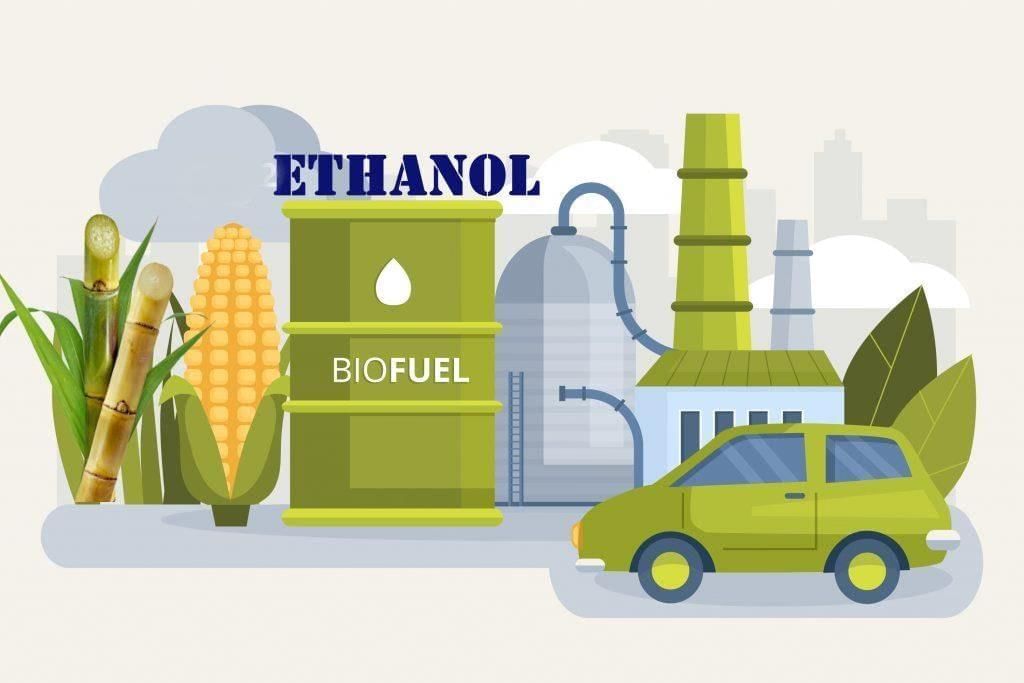 Why in News?
Why in News?
Amid the nationwide rollout of E20 fuel, concerns over reduced mileage and vehicle damage due to ethanol's corrosive nature and lower energy content have emerged.
Key Takeaways
- India has successfully rolled out E20 fuel, blending petrol with 20% ethanol, five years ahead of the 2030 target.
- The transition supports energy security, helps sugarcane farmers, and reduces crude oil imports.
- Concerns about fuel efficiency and vehicle maintenance have been raised among vehicle owners and experts.
Additional Details
- Ethanol Blending Policy: Ethanol, derived from sugarcane and other biomass, reduces carbon emissions and dependency on imported fossil fuels. The government's Ethanol Blended Petrol (EBP) Programme, launched in 2003, achieved a 10% ethanol blending (E10) milestone in 2022, with E20 rollout completed in 2025.
- Environmental and Economic Gains: The E20 program is expected to reduce India's crude oil import bill by over Rs. 50,000 crore annually and significantly cut carbon dioxide emissions. It also benefits farmers by increasing demand for sugarcane.
- Mileage Concerns: Ethanol contains about 30% less energy than petrol, potentially leading to increased fuel consumption. The Ministry of Petroleum and Natural Gas estimates a mileage loss of 1-2% for E10-designed vehicles and 3-6% for others. However, independent experts suggest real-world losses could be as high as 6-7% for non-optimized vehicles.
- Corrosion and Maintenance Issues: Ethanol's hygroscopic nature can lead to corrosion of metal components and degradation of rubber and plastic parts in vehicles not designed for E20. Major automobile manufacturers are responding by producing E20-compatible models and updating service advisories.
- Future Outlook: Discussions on higher blends like E30 or E40 are underway, but concerns about infrastructure, vehicle retrofitting, and consumer awareness need to be addressed before expansion.
The rollout of E20 fuel presents both opportunities for environmental benefits and challenges for vehicle performance and maintenance, necessitating careful consideration by consumers and manufacturers alike.
GS3/Environment
Fifth Session of Intergovernmental Negotiating Committee (INC)
Source: UN Media
Why in News?
The second part of the fifth session of the Intergovernmental Negotiating Committee (INC-5.2) focused on plastic pollution commenced in Geneva, Switzerland, highlighting the global efforts to address this pressing environmental issue.
Key Takeaways
- The INC was established by the United Nations Environment Programme (UNEP) in March 2022.
- It aims to create a legally binding treaty on plastic pollution by 2024.
Additional Details
- Formation: The INC is a UN-mandated entity allowing equal participation from all member states to collaboratively tackle plastic pollution.
- Output: The committee produces consensus-based treaties, which may include voluntary provisions, similar to earlier treaties like the Convention on Biological Diversity (1992) and the UN Framework Convention on Climate Change (1992).
- Mandate: The goal is to draft a treaty that addresses the entire life cycle of plastics, including production, design, usage, and disposal.
- Negotiation Process: The process involves various methods such as plenary sessions, technical group discussions, and stakeholder consultations.
Timeline of Sessions
- Uruguay: November–December 2022
- France: May–June 2023
- Kenya: November 2023
- Canada: April–May 2024
- South Korea: November–December 2024 (final session)
Key Debates and Goals
- Debates: Discussions revolve around the scope of the treaty, whether rules should be binding or voluntary, financing mechanisms, compliance measures, and differentiated responsibilities among nations.
- Goals: Establish global norms for production and waste management, set a combination of binding targets and voluntary approaches, create funding mechanisms for implementation, and promote a circular economy.
- Participation: The process includes input from governments, industries, civil society, Indigenous groups, and waste pickers to ensure a comprehensive approach to plastic pollution.
This session is a crucial step towards creating international standards and frameworks to combat plastic pollution, illustrating global commitment and collaborative efforts.
GS3/Environment
World Court’s Advisory Opinion Boosts Climate Action
 Why in News?
Why in News?
Climate change is a critical issue that poses a severe threat to humanity, affecting people regardless of national boundaries or political affiliations. In this context, the International Court of Justice (ICJ), the main judicial body of the United Nations, has issued a significant advisory opinion detailing the legal responsibilities of states in addressing climate change.
Key Takeaways
- The ICJ affirms that states have legal obligations to protect the global climate system.
- States cannot ignore their duties regarding climate action; these are binding obligations rather than mere political preferences.
- The ruling integrates climate obligations with established principles of international law.
- The opinion emphasizes the importance of human rights in climate policies and the accountability of states for their emissions.
Additional Details
- Legal Obligations: The ICJ's opinion clarifies that states are required to adhere to international treaties such as the UN Framework Convention on Climate Change, the Kyoto Protocol, and the Paris Agreement, establishing a legal basis for climate action.
- Accountability: By rejecting the notion that states have unlimited discretion in setting their Nationally Determined Contributions (NDCs), the ruling emphasizes that these contributions must meet legally enforceable standards.
- Intersection with Human Rights: The ICJ highlights that climate policies should respect the rights of vulnerable populations, indicating that states cannot withdraw from obligations even if they exit treaties.
- Strategic Implications: The advisory opinion serves as a critical tool for small island developing states and the Global South to advocate for stronger climate action and equitable climate finance.
The ICJ's advisory opinion marks a transformative moment in international climate law by reinforcing the legal responsibilities of states, narrowing the scope for inaction, and highlighting the relationship between environmental protection and human rights. This ruling empowers nations and advocates, signaling that failing to act on climate change is not just a political choice but a violation of legal duties.
GS2/International Relations
Intermediate-Range Nuclear Forces (INF) Treaty
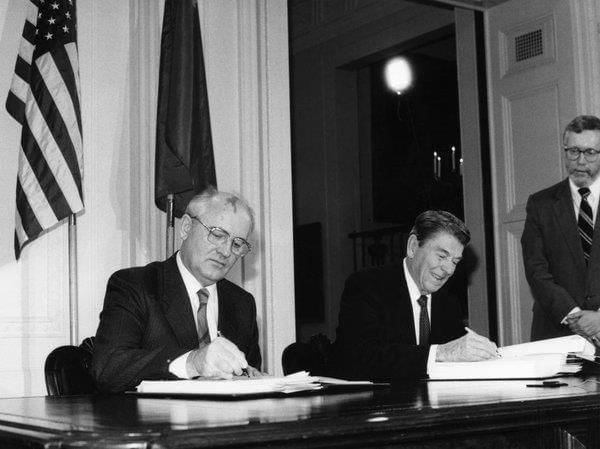 Why in News?
Why in News?
Russia has announced that it no longer considers itself obligated by the Intermediate-Range Nuclear Forces (INF) Treaty, a significant development in international arms control.
Key Takeaways
- The INF Treaty was signed in 1987 between the United States and the Soviet Union (now Russia).
- Its primary objective was to eliminate two specific categories of missile systems to mitigate the nuclear arms race.
- Both nations agreed to dismantle an entire class of ground-launched missiles with ranges from 500 to 5,500 kilometers.
- Verification measures included on-site inspections, leading to the destruction of 2,619 missiles over three years.
- The U.S. withdrew from the treaty, citing violations by Russia.
Additional Details
- Background: The need for the INF Treaty was driven by a significant buildup of missiles by both superpowers in Europe, posing a threat to continental security.
- Key Leaders: The treaty was finalized during the tenures of U.S. President Ronald Reagan and Soviet leader Mikhail Gorbachev.
- The INF Treaty marked a major milestone in arms control, fostering a period of reduced tensions between the two nations.
In conclusion, the dissolution of Russia's commitment to the INF Treaty could lead to increased tensions and a potential arms race, highlighting the need for renewed diplomatic efforts in nuclear disarmament.
GS1/History & Culture
Lalit Kala Akademi and the 64th National Exhibition of Art
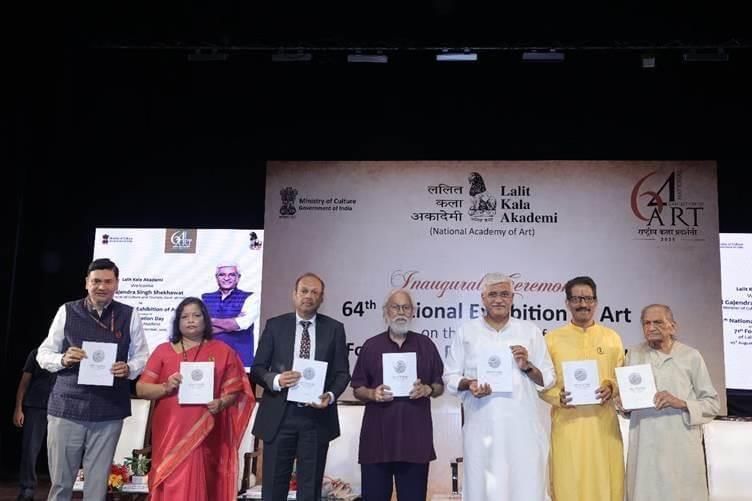 Why in News?
Why in News?
The 64th National Exhibition of Art (NEA), organized by the Lalit Kala Akademi, was recently inaugurated in New Delhi, marking a significant event in the Indian art scene.
Key Takeaways
- The exhibition showcases visual art advancements in India.
- Lalit Kala Akademi was established to promote understanding of Indian art.
- The Akademi has regional centers across various cities in India.
Additional Details
- Lalit Kala Akademi: Established on 5th August 1954 by the Government of India, it serves as an autonomous body aimed at promoting and propagating Indian art both domestically and internationally.
- Statutory Authority: Gained status under the Societies Registration Act 1860 in 1957, further solidifying its role in the art community.
- Funding: The Akademi is funded by the Ministry of Culture, which supports its various initiatives.
- Mission: It aims to identify, showcase, and preserve a permanent collection of contemporary, modern, folk, and tribal art from India.
- The NEA is recognized as the most prestigious annual event of the Akademi, beginning in 1955.
This year's exhibition emphasizes artist empowerment and showcases the rich tapestry of Indian visual art, reflecting the Akademi's longstanding commitment to cultural exchange and development.
GS2/International Relations
Sahel Region and Russia's Influence
Why in News?
Recently, Russia has strengthened its presence in the Sahel region of West Africa by signing a significant nuclear agreement with Niger. This move highlights the geopolitical interests of Russia in this strategically important area.
Key Takeaways
- The Sahel is a semi-arid region situated in western and north-central Africa.
- It spans approximately 5,000 kilometers, extending from Africa’s Atlantic Coast to the Red Sea.
- The region serves as a transitional zone between the arid Sahara desert to the north and the humid savannas to the south.
- Countries within the Sahel include Senegal, Mauritania, Mali, Burkina Faso, Niger, Nigeria, Chad, Sudan, and Eritrea.
Additional Details
- Vegetation:The Sahel is characterized by a semi-arid steppe ecosystem, primarily featuring dry grasslands. The vegetation is predominantly of the savanna type, with limited continuous cover, consisting of:
- Low-growing grasses
- Thorny shrubs
- Scattered acacia and baobab trees
- Challenges: Since gaining independence in the 1960s, the Sahel has faced challenges such as:
- Violent extremism linked to weak governance and economic decline
- Adverse effects of climate change exacerbating living conditions
- The Sahel serves as a crucial transit hub for migrants traveling from sub-Saharan Africa towards northern coastal states and further into Europe.
In summary, the Sahel region remains a focal point for geopolitical interests and humanitarian challenges, making it an area of significant concern for international relations and security.
GS2/International Relations
India-Philippines Strategic Partnership: Defence, Trade, and Maritime Cooperation
Why in News?
India and the Philippines have strengthened their bilateral relations, elevating them to a strategic partnership during President Ferdinand Marcos Jr.’s first visit to India. This partnership primarily focuses on enhancing defence collaboration, maritime cooperation, and trade relations.
Key Takeaways
- The Philippines and India established diplomatic relations in 1949.
- Bilateral trade surpassed USD 3 billion for the first time in 2022-23 and reached USD 3.53 billion in 2023-24.
- Defence cooperation has become a key element, highlighted by India's sale of BrahMos missiles to the Philippines.
- Both nations have committed to doubling bilateral trade by 2030.
- People-to-people engagement has been emphasized through scholarships and youth exchange programs.
Additional Details
- Historical Background: India and the Philippines share a history of engagement rooted in democratic values and anti-colonial legacies, evolving steadily over decades.
- Trade and Economic Cooperation: A trade agreement signed in 1979 paved the way for increased bilateral trade, which has grown significantly since the late 1990s due to India's Look East Policy. Major exports from India include engineering goods and pharmaceuticals, while imports from the Philippines comprise semiconductors and electrical machinery.
- Defence and Maritime Cooperation: India's defence exports to the Philippines began with a significant USD 375 million deal for BrahMos missiles, marking a pivotal shift in military collaboration amid regional maritime security concerns.
- People-to-People Engagement: The enhancement of educational ties through ITEC scholarships aims to foster closer relations between the two nations.
The recent visit signifies a transformational moment in India-Philippines relations, with both leaders expressing strong commitments to regional peace and stability, particularly in the context of a free and open Indo-Pacific. President Marcos hailed India as an "indispensable partner," while Prime Minister Modi acknowledged the Philippines' trust in Indian defence capabilities.
|
287 docs|142 tests
|
FAQs on Weekly Current Affairs (1st to 7th August 2025) - 2 - Weekly Current Affairs - UPSC
| 1. What are the primary environmental challenges faced by India related to rainfall and natural disasters? |  |
| 2. How does the Supreme Court ruling on pollution control impact environmental regulations in India? |  |
| 3. What was the significance of the Intermediate-Range Nuclear Forces (INF) Treaty for global security? |  |
| 4. What are the benefits and challenges of ethanol blending in fuel? |  |
| 5. How does the India-Philippines strategic partnership enhance defense and maritime cooperation? |  |





















